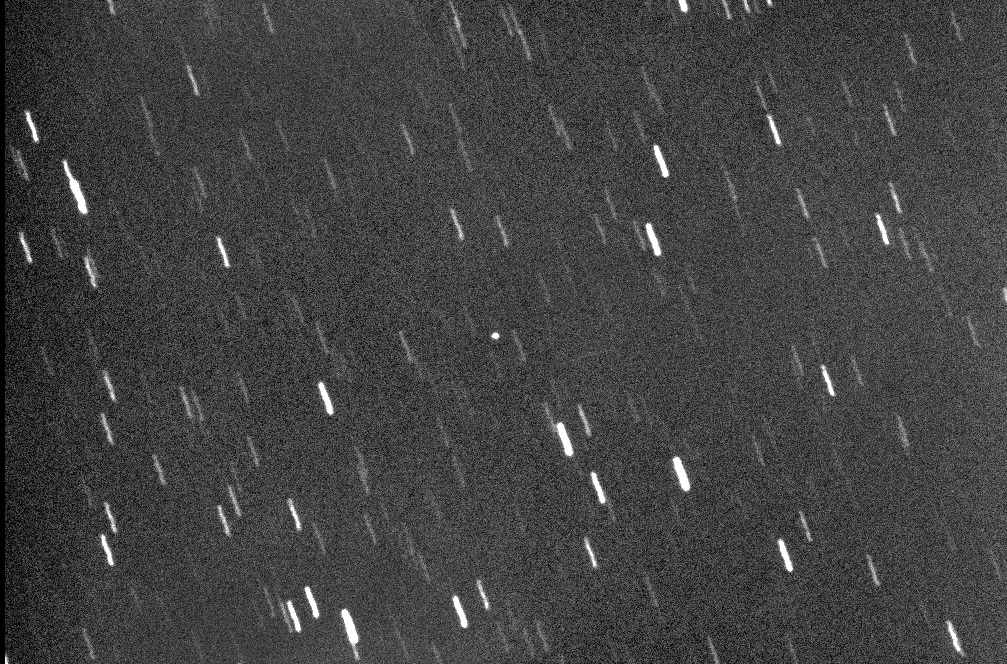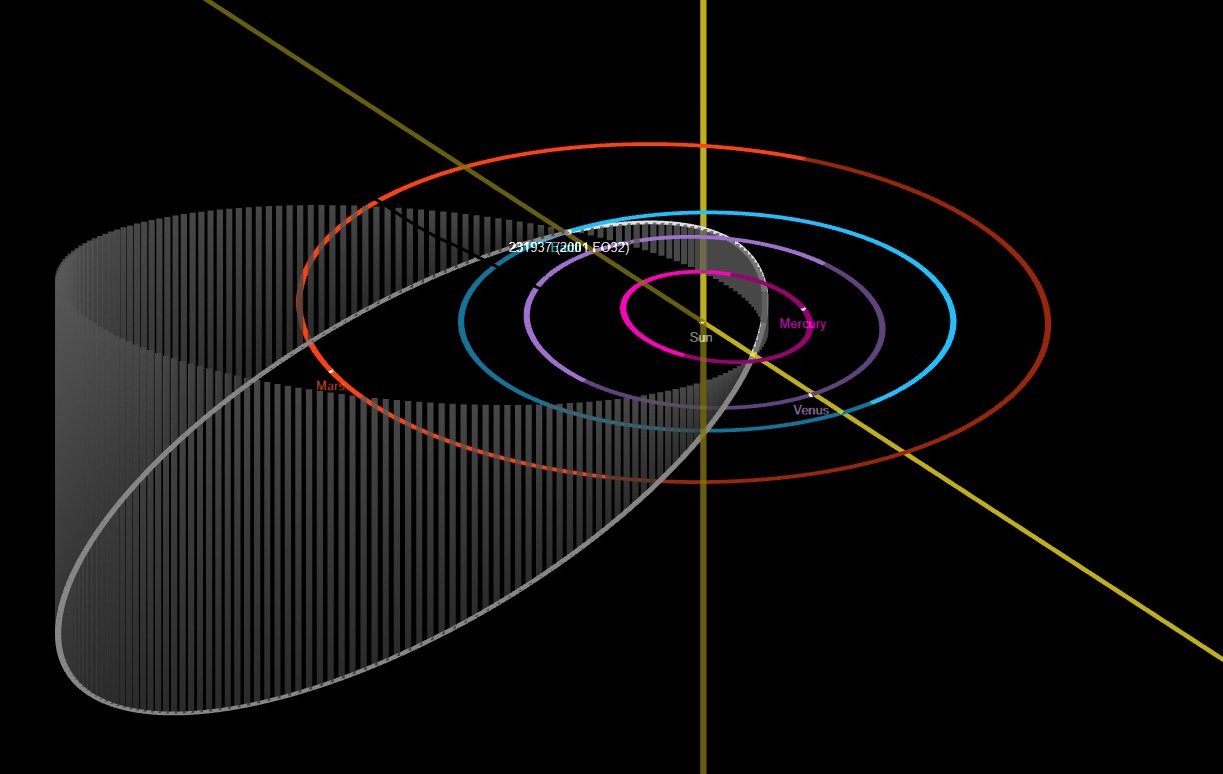The biggest asteroid to visit Earth in 2021 zooms by our planet unusually fast today
Asteroid 2001 FO32 is moving at 77,000 mph (124,000 kph) but poses no danger.
The biggest asteroid to visit Earth this year is zoomimg by our planet today (March 21) and it's a real speed demon.
The asteroid 2001 FO32 is hurtling through space at an unusually fast speed for a space rock, about 77,000 mph (124,0000 kph), and will pass by Earth at a safe range of 1.25 million miles (2 million kilometers), according to NASA. It won't come this close to Earth again until 2052.
Asteroid 2001 FO32 is up to 2,230 feet (680 meters) wide and poses no impact risk to the Earth, but its speed is peculiar, the agency said.
"The reason for the asteroid's unusually speedy close approach is its highly inclined and elongated (or eccentric) orbit around the sun, an orbit that is tilted 39 degrees to Earth’s orbital plane," NASA officials wrote in a statement. "This orbit takes the asteroid closer to the sun than Mercury and twice as far from the sun as Mars."
Astrophysicist Gianluca Masi of the Virtual Telescope Project in Ceccano, Italy spotted asteroid 2001 FO32 with a telescope in the days before today's flyby. His video and images show the asteroid as a bright moving object in the sky.
Video: Watch asteroid 2001 FO32 move across the night sky


Like a rock rolling down a hill, asteroid 2001 FO32 picks up speed as it falls inward toward the sun and then slows as it heads back out toward Mars. The asteroid takes more than two years (810 days to be exact) to complete one orbit and won't pose an impact risk to the Earth for centuries, despite 2001 FO32's classification as a "potentially dangerous asteroid," NASA said.
Get the Space.com Newsletter
Breaking space news, the latest updates on rocket launches, skywatching events and more!
"We know the orbital path of 2001 FO32 around the sun very accurately, since it was discovered 20 years ago and has been tracked ever since," said Paul Chodas, director of the Center for Near Earth Object Studies (CNEOS) overseen by NASA's Jet Propulsion Laboratory (JPL) in Southern California. "There is no chance the asteroid will get any closer to Earth than 1.25 million miles."
NASA and astronomers around the world regularly seek and track asteroids that could pose an impact hazard to Earth. Asteroid 2001 F032 was first spotted in 2001 by the Lincoln Near-Earth Asteroid Research (LINEAR) program in Socorro, New Mexico. Observations by NASA's NEOWISE space telescope suggest the asteroid is between 1,300 and 2,230 feet (440 to 680 m) wide.
"Even if it is at the smaller end of the scale, 2001 FO32 will still be the largest asteroid to pass this close to our planet in 2021," NASA officials wrote. "The last notably large asteroid close approach was that of 1998 OR2 on April 29, 2020. While 2001 FO32 is somewhat smaller than 1998 OR2, it will be three times nearer to Earth."

At its closest point to Earth today, asteroid 2001 FO32 will be about about 5.25 times the distance between the Earth and moon. Still, astronomers will watch the asteroid closely with telescopes to learn more about its size, brightness and composition.
"We're trying to do geology with a telescope," Vishnu Reddy, associate professor at the University of Arizona's Lunar and Planetary Laboratory in Tucson, said in the statement.
Astronomers have been using NASA's Infrared Telescope Facility atop Mauna Kea in Hawaii in recent days to determine its chemical composition. They may also use NASA's Deep Space Network of radio dishes to bounce signals off asteroid 2001 FO32 to measure its orbit, how fast it spins and even determine some surface features like craters.
Related: Huge asteroid Apophis revealed in photos
"Observations dating back 20 years revealed that about 15% of near-Earth asteroids comparable in size to 2001 FO32 have a small moon," Lance Benner, principal scientist at JPL, said in the statement. "Currently little is known about this object, so the very close encounter provides an outstanding opportunity to learn a great deal about this asteroid."
The asteroid may also be visible to amateur astronomers in the Southern Hemisphere as it passes by Earth, but it may be a challenge to track.
"The asteroid will be brightest while it moves through southern skies," Chodas said. "Amateur astronomers in the southern hemisphere and at low northern latitudes should be able to see this asteroid using moderate size telescopes with apertures of at least 8 inches in the nights leading up to closest approach, but they will probably need star charts to find it."
Asteroid 2001 FO32 is actually one of two asteroids passing by Earth today, according to NASA's Asteroid Watch website that lists such flybys. The second asteroid, called 2021 FH1, is about 97 feet (30 m) wide and will pass Earth at a distance of 973,000 miles (1.5 million km). It was first detected by astronomers on Friday (March 19).
Email Tariq Malik at tmalik@space.com or follow him @tariqjmalik. Follow us @Spacedotcom, Facebook and Instagram.
Join our Space Forums to keep talking space on the latest missions, night sky and more! And if you have a news tip, correction or comment, let us know at: community@space.com.

Tariq is the Editor-in-Chief of Space.com and joined the team in 2001, first as an intern and staff writer, and later as an editor. He covers human spaceflight, exploration and space science, as well as skywatching and entertainment. He became Space.com's Managing Editor in 2009 and Editor-in-Chief in 2019. Before joining Space.com, Tariq was a staff reporter for The Los Angeles Times covering education and city beats in La Habra, Fullerton and Huntington Beach. In October 2022, Tariq received the Harry Kolcum Award for excellence in space reporting from the National Space Club Florida Committee. He is also an Eagle Scout (yes, he has the Space Exploration merit badge) and went to Space Camp four times as a kid and a fifth time as an adult. He has journalism degrees from the University of Southern California and New York University. You can find Tariq at Space.com and as the co-host to the This Week In Space podcast with space historian Rod Pyle on the TWiT network. To see his latest project, you can follow Tariq on Twitter @tariqjmalik.









